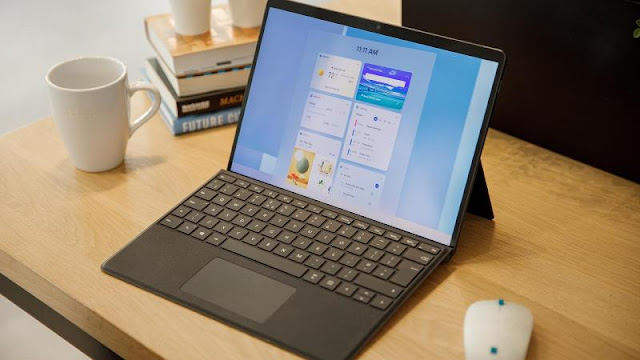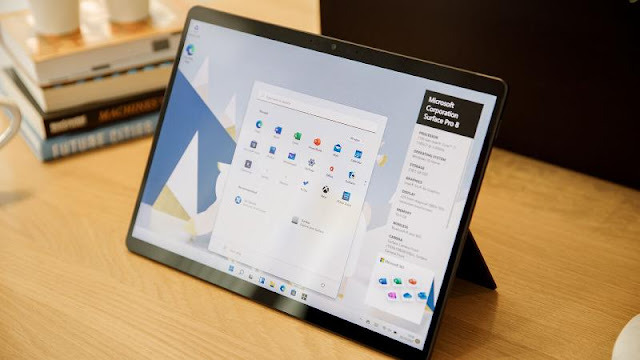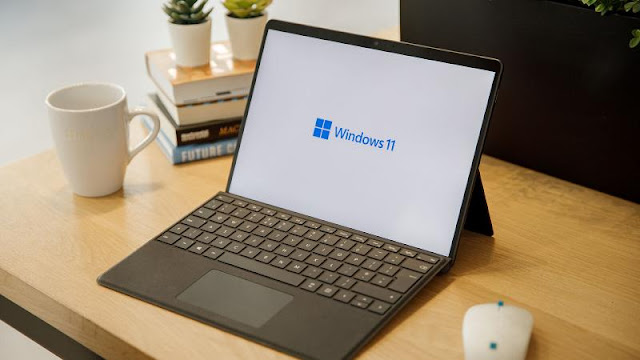The Surface Pro 8 is a huge upgrade over its predecessor, but it comes at a cost – even before you factor in the keyboard cover that’s sold separately.
Should I Buy The Microsoft Surface Pro 8?
Pros
- Excellent 120Hz display
- Premium design
- Great performance
- Solid battery life
Cons
- Expensive
- Limited ports
- Pure tablet experience still needs work
Our Verdict
Price When Reviewed
- From $1,099.99 | Model reviewed $1,599.99
Microsoft has been making Windows tablets for almost a decade, but it hasn’t always been plain sailing for the company. 2012’s first-gen device, known simply as ‘Surface’, ran stripped-back software known as Windows RT and didn’t prove popular with most consumers.
However, it wasn’t long before the Surface Pro line established Microsoft as the default Windows 2-in-1 maker. That remains the case to this day, despite increased competition from the likes of Dell, Lenovo and Huawei.
But after six years of iterative updates, Microsoft has finally introduced wholesale changes with the Surface Pro 8. There are smaller bezels, a larger 120Hz display, better battery life and an upgraded rear camera. That’s before you get to the customary processor upgrade.
But is that enough to justify the higher asking price? Or is it time to seriously consider the growing number of alternatives? Here’s my full review.
Design & Build
- Larger display within near-identical body
- Impressive video calling features
- No USB-A ports
The design of the Surface Pro 8 strikes a balance between being instantly familiar but also a genuine upgrade. Its magnesium alloy construction looks and feels as premium as ever, even if you are limited to the same two colour options – Platinum (silver) or Graphite (black).
A matte finish adds plenty of grip without any visible fingerprint smudges. It also means the Pro 8 is comfortable to use as a tablet case-free, although at 891g you’ll want to prop it up during extended usage.
That’s where the built-in kickstand comes in. It extends across the full width of the back of the device, enabling positions from fully vertical to only slightly raised off the table. There are no changes here compared to the Pro 7, but a tough metal hinge makes it feel impressively robust and sturdy.
It’s a noticeable upgrade over the 8Mp sensor on the last few generations of Surface Pro, but you still shouldn’t use it regularly for photography. Aside from the unwieldy nature of the device, stills from the Pro 8 are still relatively hit-and-miss.
Good lighting conditions can yield some nice shots, but exposure is a frequent problem and dynamic range often lacking. It’s useful for document scanning and reference, but probably not much more.
The 5Mp front-facing lens is of similar quality, but that makes it a great option for video calls. It’s capable of 1080p footage, something many built-in laptop webcams still can’t match. This is a key strength of many Surface computers, especially when paired with dual studio microphones.
Next to it, you’ll find a separate infrared lens, meaning the Pro 8 supports Windows Hello face unlock. This is easy to set up and works extremely well, with an extra scan recommended if you wear glasses. It’s your only option for biometric unlocking, with no fingerprint scanner on the device itself or either of the compatible keyboard covers.
The key design upgrade you’ll probably notice is much slimmer bezels, which allows for a larger 13in display within almost the same footprint. That makes it feel closer to a laptop than ever before, although the tablet itself is significantly lighter.
It's mostly business as usual on the sides of the device, where you’ll find the power button, volume rocker, 3.5mm headphone jack and docking station for keyboard covers.
Microsoft has stuck with the proprietary Surface Connect as the main charging method, although you can use either of the USB-C ports instead. These support Thunderbolt 4 for fast data transfer, but the USB-A port has been ditched. If you’re anything like me, that means connecting an adapter or hub on a regular basis - it feels like an unnecessary change.
- Excellent, laptop-like keyboard
- Slim Pen 2 is excellent
- Both are expensive additional accessories
Disappointingly, Microsoft still sells all the Surface Pro 8 accessories separately, despite the keyboard being a required purchase for most people.
However, the company is at least bundling the latest Signature Keyboard with its new Slim Pen 2. There’s even a built-in storage location for the stylus above the keyboard, which charges it at the same time. I prefer this to a pen that magnetically attaches to the top of the device, especially as this new design keeps it out of the way if you just want to type.
Pairing via Bluetooth is automatic, while I noticed no input delay throughout my testing time. Palm rejection is excellent too, although I can’t verify Microsoft’s claim that it supports 4096 levels of pressure sensitivity.
The size of the Surface Pro 8 means there’s now plenty of room for a full-size keyboard. The Signature Keyboard offers an accomplished typing experience, comparable to what you’ll find on the Surface Laptop 4. Both are coated in a soft-touch Alcantara fabric, while backlit keys are a major advantage over some rivals.
Screen & Speakers
- 13in LCD display
- 120Hz refresh rate, but not yet adaptive
- Great speakers
The Surface Pro 7’s display was hardly a weakness, but Microsoft has made upgrading it a priority. As I alluded to earlier, the screen size has increased from 12.3in to 13in, but it maintains a 3:2 aspect ratio. That means there's a new 2880x1920 resolution, although this 'PixelSense Flow' display is still LCD and not OLED.
Microsoft advertised a Dynamic Refresh Rate (DRR) feature at the Windows 11 launch in 2021, which would allow the Surface Pro 8 and selected other devices to automatically adjust refresh rate depending on the situation. This should help conserve battery life, but it’s still not available at the time of writing in March 2022.
The Pro 8 continues with dual 2W stereo speakers, which output via large grilles on either side of the device. They deliver rich, punchy audio that you wouldn’t necessarily expect from a device this size.
There’s a decent level of bass and it doesn't become distorted at high volumes, while Dolby Atmos support enables room-filling sound. Audiophiles will still need to connect headphones or external speakers, but it’s an excellent experience for casual users.
Specs & Performance
- 11th-gen Intel processors & integrated GPUs
- Excellent performance across the board
- Removable SSD on cheaper models
Microsoft has upgraded the internals on every iteration of the Surface Pro, and that’s no different here. The Pro 8 is powered by Intel’s 11th-gen processors – the device was released before Intel announced its latest CPUs in January 2022.
You have a choice here between the Core i5-1135G7 and Core i7-1185G7, although I can only comment on the latter. Alongside Iris Xe integrated graphics and 16GB of RAM on this mid-spec model, performance is predictably excellent.
The Pro 8 excels across all the most common productivity tasks, from web browsing and checking email to video calls and multitasking. Throughout my time with the device, there was no stuttering, hesitations or app crashes, even with multiple programs open simultaneously. However, in these scenarios you will notice the back of the device feel warm to the touch.
More demanding use cases such as video editing and light gaming are also within reach, but that’s when you’ll also notice the fans kicking in. This doesn’t get particularly loud, but it can be distracting at times.
Still, this solid performance is reflected in the benchmarks below. It ranks as one of the most capable 2-in-1s you can buy:
All configurations of the Pro 8 have SSD storage, although the entry-level model is limited to just 128GB. However, this and 256GB variants have a removable SSD, meaning they can easily be swapped out when close to capacity. That’s not a feature you’ll find if opting for 512GB or 1TB of storage.
Software
- Runs Windows 11
- Still doesn't feel optimised for touch input
The Surface Pro 8 launched around the same time as Windows 11, making it one of the first devices running Microsoft’s OS out of the box. It’s also one of the first in line for new updates, but Surface devices don’t get preferential treatment over other Windows manufacturers.
It’s certainly still usable, but you’ll need to be patient and get used to Windows 11’s quirks if you haven’t used it before. However, recent developments suggest Microsoft is making touch input a priority, so it might feel much more optimised in a few months’ time.
Battery Life & Charging
- Estimated 50.2Wh battery
- Solid, all-day battery life
- 65W charging via in-box adapter
As usual, Microsoft doesn’t quote a specific battery capacity for the Pro 8, but SurfaceTip claims it’s a 50.2Wh cell. That’s supposedly slightly lower than the Surface Pro 7+, but a noticeable increase on the 43.2Wh battery in the Pro 7.
Microsoft says it’ll get you ‘up to 16 hours of typical device usage’, but doesn’t specify what that involves. It fell slightly short of that claim in our 720p video loop test, with a time of 12 hours and 39 minutes.
This only serves as a measure of screen-on time, especially with the brightness set to a relatively low 120 nits. Refresh rate was set to the standard 60Hz, while battery saving mode was disabled.
Changing any of these things will affect battery life, but a full working day on a single charge is well within reach. That's at risk if you stay at 120Hz, but the upcoming Dynamic Refresh Rate feature should allow for the best of both worlds.
Price
With no Core i3 model and several key upgrades, a price increase on the Surface Pro 8 was always likely. It now starts at £999/US$1,099.99, but can be dialled all the way up to £2,459/$2,599.99.
The mid-spec model I tested will set you back £1,499/US$1,599.99.
Remember, that’s just for the tablet itself. Adding the new Signature Keyboard with Slim Pen 2 will set you back another £259.99/US$279.99. If you don’t have a Bluetooth mouse already, the new Ocean Plastic Mouse is an extra £24.99/US$24.99.
Verdict
The Surface Pro 8 is the device many people have been waiting years for. Microsoft has finally updated its design, with a larger display and slimmer bezels bringing it closer to a traditional laptop than ever before.
While not OLED, the gorgeous screen is now a buttery-smooth 120Hz, while performance from 11th-gen Intel chips is excellent. Other highlights include a great video calling experience, solid battery life and impressive speakers.
The new Signature Keyboard and Slim Pen 2 are excellent accessories for the Pro 8, but they’re also symptomatic of its main issue. In addition to a higher starting price, Microsoft expects you to pay hundreds of pounds/dollars extra for the full experience.
With that in mind, you have to be extremely confident that the Surface Pro 8 can rival the best laptops available right now. If it’s not going to be your primary productivity device, it’s worth considering more affordable options.
Specs
- 13in 2880x1920 LCD display, 120Hz refresh rate (adaptive)
- Intel Core i5-1135G7/i7-1185G7 processor
- Intel Iris Xe graphics
- 8/16/32GB RAM
- 128GB/256GB/512GB/1TB SSD storage
- Windows 11 Home
- 10Mp rear camera
- 5Mp front-facing camera with Windows Hello
- Front-facing stereo speakers with Dolby Atmos
- Bluetooth 5.1
- Up to 16h battery life (quoted)
- 891g (tablet only)










0 comments:
Post a Comment